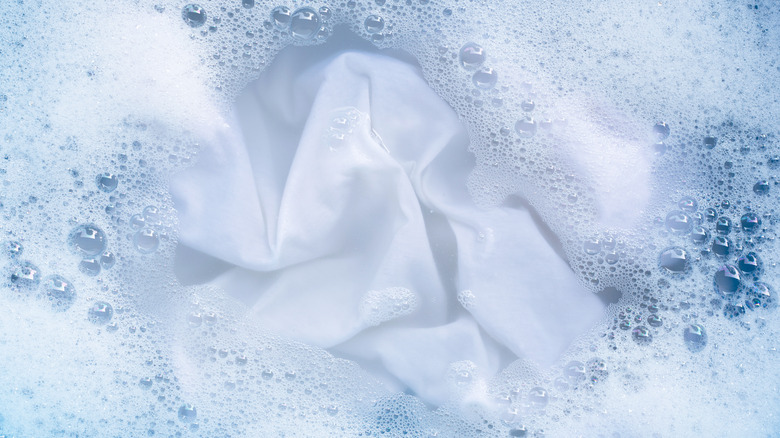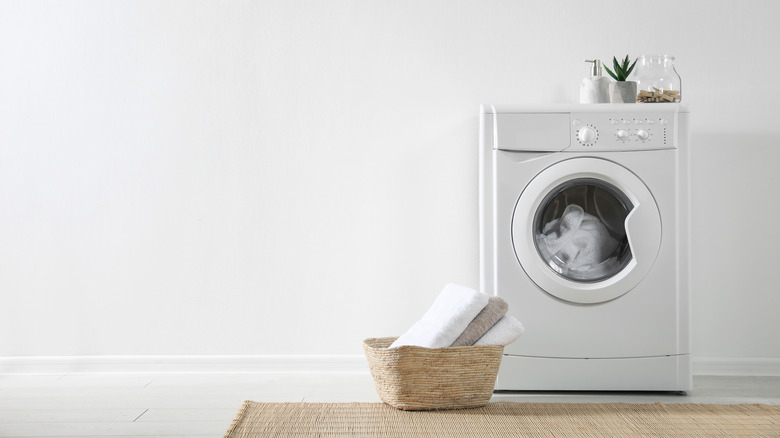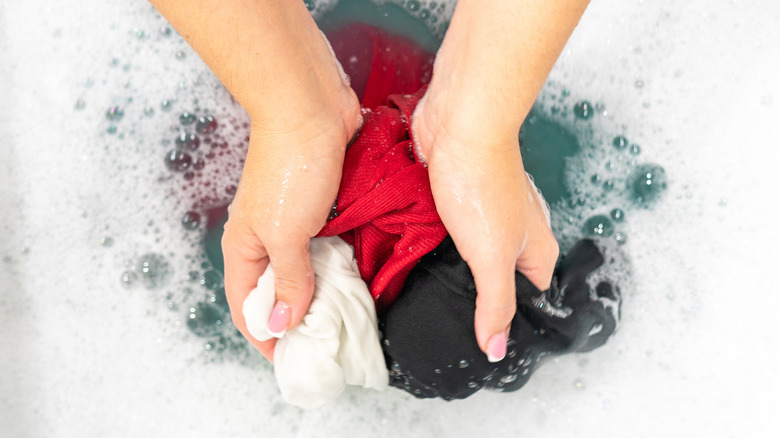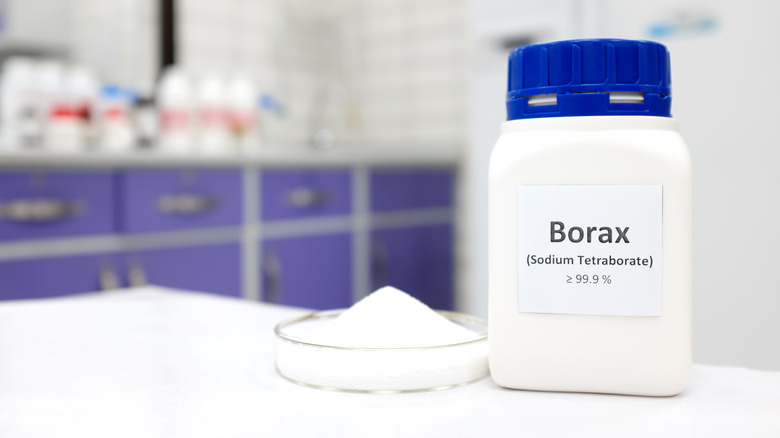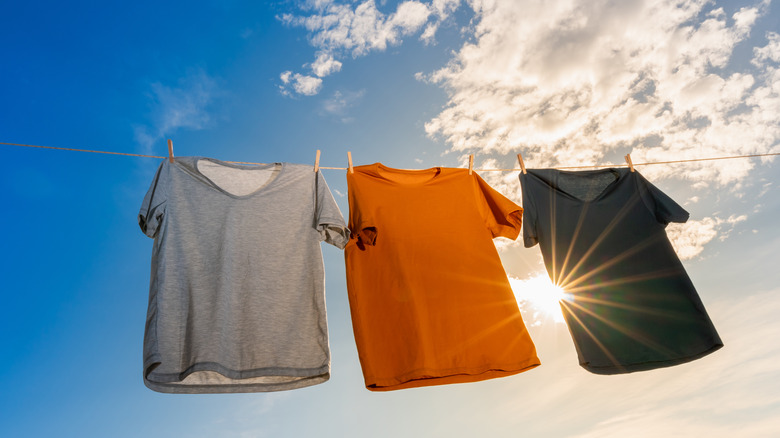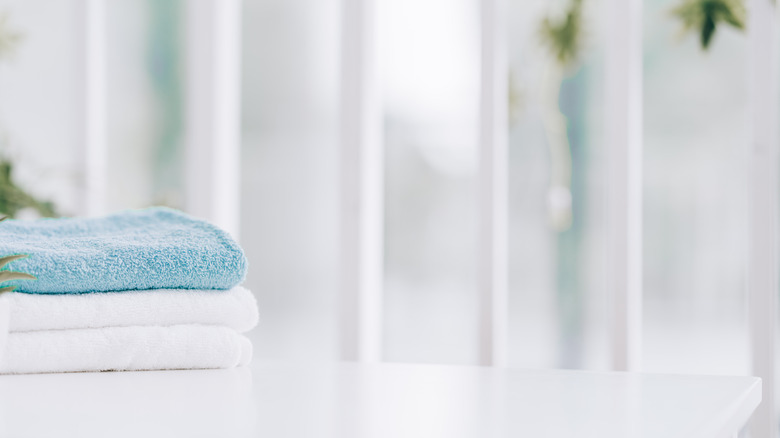What Is Laundry Stripping And Is It Bad For Clothes?
"How to" videos are always fun to watch and learn from. In fact, you may have seen videos on social media that show people putting their clean laundry into a bathtub that's completely filled with a cleaning solution. Shortly after, you notice that the laundry emits dark clouds of gross-looking dirt and grime, and it's a real eye-opener. Laundry stripping has been a major trend on TikTok and Instagram over the last couple of years. While this isn't a brand new cleaning technique that was just invented, the task of laundry stripping has skyrocketed in popularity recently. It should be no surprise that the method took off because of its existence all over social media, because there's something weirdly satisfying about seeing all of that disgusting residue left over in the water. And let's face it: Watching something new on Tiktok is always a fun treat — even if it is cleaning a bit of dirty laundry.
Watching videos of laundry stripping actually made many viewers question whether or not their clothing and linens were harboring that much invisible gunk that they witnessed. It's also unsurprising that this cleaning trend emerged in the midst of the COVID-19 pandemic when everyone was confined to their homes and looking for ways to while away the hours. It was a perfect time to watch videos, learn new tips, and try new things with extra time on the weekends. Read on to learn all about laundry stripping and whether it's safe for your clothes.
What is laundry stripping?
The purpose of laundry stripping is to ensure your garments, bedding, and towels are ultra-clean by removing unwanted residue from the surface that has built up. It's a way to deep clean your linens to leave them feeling fresh and cleaner than ever before. That sounds pretty reasonable, right? It's pretty disturbing — not to mention unfair — to think that laundry that you recently washed with care, dried, and folded is sitting in a pile with a residue on it.
Rosa Nogales-Hernandez, head home cleaning valet for Valet Living, explained to Better Homes & Gardens, "It helps to remove all residues from laundry soap, fabric softener, minerals from hard water, and body oils," adding that, "Essentially, it gives your laundry a second chance to be as fresh and crisp like it's the very first wash." The chemicals break down these substances so that they are released from the fabric, which is what causes the water to look so dirty.
If you've never heard of laundry stripping thus far, we're guessing that we may have your undivided attention. As a matter of fact, you may want to try to do a bit of laundry stripping yourself and test this all out. So continue reading, because we're going to tell you how this popular cleaning process is done.
How do you strip laundry?
Let's get started. In order to strip your laundry, you'll first need to gather up some supplies that you may already have in your cabinet. The process requires Borax, powdered laundry detergent, and washing soda, along with some piping hot water (via Better Homes & Gardens). While it's easiest to strip your laundry in a bathtub, those who live in homes without tubs can work in smaller batches using buckets or other sturdy plastic containers right in the kitchen sink.
First, you're going to fill your tub (or big bucket if you don't have one) with really hot water. Then, create your cleaning mixture of Borax, powdered laundry detergent, and washing soda following a 1:1:2 ratio (via Good Housekeeping). To fill an entire bathtub, you'll need about a quarter of a cup of Borax, a quarter of a cup of washing soda, and half a cup of laundry detergent. Mix the formula into the water until all the powder has dissolved. Then, add your bedsheets or towels to the water. Let everything soak while you wait for the water to cool down — stirring occasionally — which should be between four and five hours. When you're done, throw the fabric into your washing machine, and run a rinse cycle. That's literally it!
Does laundry stripping actually work?
One of the major misconceptions about laundry stripping is that all of the brown water you see in your tub is actually made up of dirt. While that's certainly part of it, many viral videos feature dark clothing or towels. This means that the water color you're seeing may actually be a result of dyes running rather than just grime. While laundry stripping certainly removes leftover residue from linens, the bigger question is whether it's really necessary.
According to Real Simple, a major reason why many bloggers had satisfying results after stripping their laundry is because they weren't necessarily washing it correctly to begin with. If you use a homemade laundry detergent, for example, it might be lacking some of the key chemicals that keep your clothing, sheets, and towels squeaky clean. Depending on the ingredients you use, it may even be leaving unwanted residue on the fabric. Another potential mistake is using too much laundry detergent, whether you're working with a commercial product or a DIY solution. Before stripping your laundry, try to simply reduce the amount of detergent you use to see if it rectifies the problem.
Is laundry stripping bad for clothes?
You really need to proceed with a bit of caution, as not all clothing will hold up to laundry stripping. Any fabric that needs to be washed in cold water, for example, may be damaged by the hot water soak. There are certain types of clothing that you should never strip, according to Maytag. Dark clothing and linens aren't the best candidates because the dye may run, while clothing containing spandex may deteriorate due to the PH level of the stripping solution. Also, avoid stripping any garments which are made of wool, because the process will remove the lanolin, a naturally occurring oil that actually protects the fabric.
Some of the best candidates for laundry stripping are towels and sheets, because they're designed to withstand wear and tear and are also susceptible to experiencing the detergent buildups that stripping eliminates. It's also important to be careful when mixing fabrics of different colors. Since dyes may bleed, you might inadvertently dye your white towels if you strip them alongside colorful materials.
How often should I strip my laundry?
If you're washing your laundry correctly, you shouldn't have to strip it more than a couple of times each year. There are some practices, however, that may make stripping necessary. Using fabric softeners and dryer sheets, for example, can result in a sticky residue on your fabrics. Those living in regions with hard water may also find they need to strip their fabrics more frequently. You'll know when laundry needs to be stripped when towels feel like they're coated in a sticky substance or sheets start to look yellow or smell musty.
Mary Begovic Johnson, a principal scientist for Tide, cautioned against stripping your laundry too often. As she put it, "We do not recommend doing this frequently as it can prematurely age and damage clothes" (via Better Homes & Gardens). If you don't want to go through the entire stripping process on a regular basis, you can also simply add Borax or washing soda to your standard wash cycle (via Good Housekeeping).
